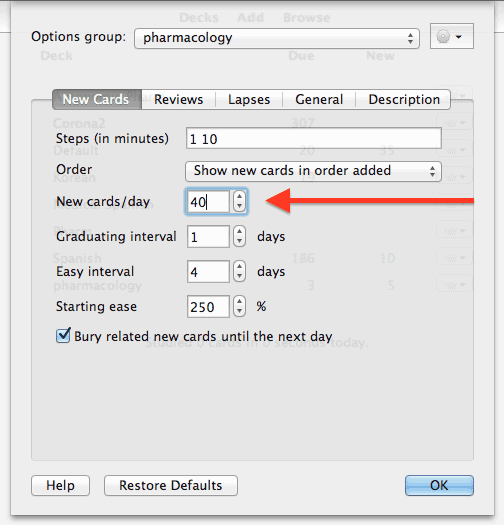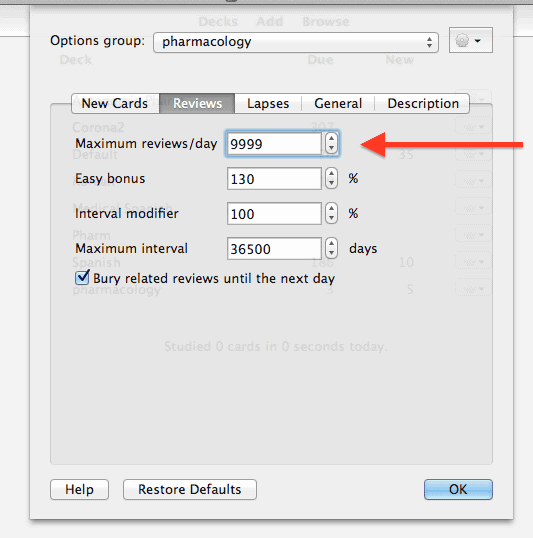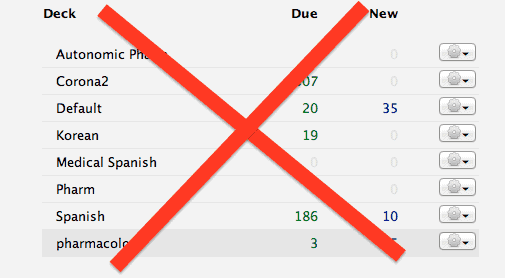
Anki is one of the most powerful tools in medical school. Most medical students have used Anki for the USMLE Step 1, Step 2CK, and Shelf exams. They pray for high scores that will lead them to the residency of their dreams.
However, not everyone who uses Anki does well. In fact, tons of students use spaced repetition but end up buried in worthless flashcards.
The sad truth is most Anki cards are worse than useless for the USMLEs. Why? Because they focus too much on rote memorization. Their cards test random facts that distract them from understanding key concepts.
I made a lot of mistakes using Anki and found out the hard way what it took to reach 270 on the USMLE Step 1. Here, I answer your most pressing questions, including:
- The best kinds of Anki cards you should make
- The ideal Anki settings
- How many new cards/day you should be doing (and what is too much)
- How to study for your USMLEs during clerkships
- The best way to do your cards while on the wards
- Why some Anki cards are better than others
- And much more
Table of Contents
1. What is Anki? Why Do So Many Medical Students Use It?
Short Answer:
Spaced repetition generally, helps you remember what you’ve learned, forever. Anki is a flashcard-based program that uses spaced repetition. It really works.
Detailed Answer:
Anki is a free computer program that uses spaced repetition. Spaced repetition is an empirically-derived method to remember something you’ve learned, forever.
Medical school involves learning vast amounts of information. As such, more and more med students use Anki to maximize their learning.
2. Med School + Anki: Too Good to Be True? What Are Med Students’ Most Common Anki Mistakes?
Short Answer:
Anki has the potential for fantastic good. However, it’s not a cure-all. The three most common mistakes students make with Anki are:
- Memorizing lists of facts without understanding the underlying concepts
- Making cards on everything that “might” be useful
- Not doing their Anki reviews every day
Detailed Answer:
Anki sounds amazing. When I first began, it almost seemed too good to be true. Like you, I was frustrated to learn things only to forget them days later. I decided to take the plunge and turn as much of what I’d learned into efficient Anki cards as possible.
My experience was remarkable. I’m more than 10+ years into my Anki “experiment” I started as a Stanford first-year. I can remember – and use – virtually everything I made into cards over that time (med school + residency). Having 10+ years of medical training at easy recall makes:
- Learning new things faster and more enjoyable
- Studying for my anesthesia boards less time-consuming (I didn’t need to study for most of them, in fact)
- Making connections in my day-to-day much easier
Using Anki Can Change Your Life
Imagine that instead of memorizing everything, you learned the reasons behind it. Like, instead of memorizing the functions of the rotator cuff muscles, you connected their actions to their insertions/origins. Or that cystitis causes urinary urgency, you learned the actual mechanism.
Now imagine that you could remember all of those connections you’d made for the past year. Or 10 years.
To paraphrase Jay-Z’s immortal words:
I got 99 problems, but forgetting medical knowledge ain’t one
However, many med students’ experiences with Anki are much less pleasant. They spend all day cramming details and dread their 1000+ daily reviews. Despite memorizing pages of First Aid, they can’t interpret labs to save their lives. When asked questions on rounds, their mind goes blank. Many are shocked by their low NBME and USMLE scores.
Why have my Anki experiences diverged so much from the typical med student’s? The reasons are myriad, however, here are the three most common mistakes med students make with Anki. They are:
1. Memorizing Lists of Facts Without Understanding the Underlying Concepts
Med school exams are very fact-/memorization-heavy. It’s easy to believe memorization will also lead you to USMLE success. However, that would be a huge mistake.
The NBME, writers of the USMLEs and Shelf exams, publish their test-writing rules. Every USMLE question-writer wants you to apply essential concepts. They design test items to discourage memorization, and to punish crammers.
Don’t believe me? Read about how the NBME writes questions here.
One of the most common mistakes students make is to make memorization-heavy cards. They can recite long lists of facts, but can’t make sense of them. On med school exams, they may excel. But by the time they realize their mistake during USMLE prep, it’s almost too late.
Be sure to make cards that focus on mastery, rather than memorization. You can learn more advice here.
2. Making Cards on Everything That “Might” Be Useful
Spaced repetition is powerful. To me, it was life-changing. However, when doing Anki cards, the temptation is to overdo it. Specifically, students will try to make cards on everything. They’ll memorize every line of their class PowerPoints. Why? Because they’re hoping for a few extra points on school exams. They can’t bear the thought of not knowing everything.
The problem with making cards on everything is the opportunity cost. To make cards on everything, you will be taking time away from other vital activities. Things like:
- Mastering question interpretation, the skill you’ll need to score 240+ on any USMLE
- Learning new concepts
- Doing UWorld or other QBank questions
Knowledge is essential, and mastery is critical. However, it’s easy to go overboard and let Anki take over all your day.
Remember, you need knowledge AND to know how to interpret a question correctly. Having only one will only get you so far.
Instead, focus on making cards on the most critical topics. You can use First Aid as a good starting point.
Struggling to make your own cards? Check out my guide to how to create basic Anki cards for medical students.
3. Not Doing Their Anki Reviews Every Day
Anki works best if you do your reviews every single day. Once you “learn” a new card, the program will show you that card the next day. Assuming you continue to answer that card correctly, Anki will show you that card at increasing intervals.
The key: you must do your cards every day. Falling behind causes you to:
- Forget more information, which increases the amount of time wasted on re-learning the material
- Want to do your cards even less. You might have 300 reviews due in a day. However, if you don’t do those cards, it might balloon to 500 reviews, which is even harder to do.
Overwhelmed with the idea of making cards AND integrating them into your day? Use the Yousmle Step 1 or Step 2 CK Decks to help you master everything faster.
3. Can I Start Anki If I Only Have a Couple Months Before my USMLE? What is the Best Way to Start?
Short Answer:
Absolutely. Start slow, and if you’re struggling to make your own cards, use the Yousmle Anki cards.
Detailed Answer:
I’ve tutored med students for USMLE Step 1, Step 2CK, and shelf exams for 10+ years. Many students successfully integrate Anki into their routine. But can you start Anki with only a few months before an exam?
Ask yourself this: how long can you remember something you’ve studied? If you’re like most people, it’s a week. If you’re lucky. The rate of forgetting is exceptionally high, especially if you memorized the information.
I was no different. Before Anki, I’d remember things for a week or two, at most. If I saw it again, I’d think, “I know I’ve studied that before…” but the information wouldn’t come. My mind would blank.
If you have more than 2-3 weeks before your exam, you will have to re-learn things after a couple weeks. As such, it is much more efficient to use Anki, so you don’t have to re-learn anything.
Like anything new, there will be a learning curve. My advice is:
Make a Limited Number of Cards Per Day
Target a reasonable amount of cards you will make a day, like 30-40. Setting a limit on cards you create will focus you on more essential facts over unnecessary details.
Don’t Make Super Detailed Cards; Avoid Lists When Possible
Remember, students who memorize lists/facts do poorly on the USMLEs by design. Instead, you want to focus on mastery of the material and using Anki to retain the mastered content.
Start With Simple Cards (or Use the Yousmle Anki Cards to Make Better Cards)
If you’re planning on making your own cards, start by making simple cards. It’s hard to make good cards when you start. Instead, focus on basic “flashcard” type cards in simple subjects. Subjects like pharmacology are more fact-based. As such, pharmacology is a bit easier to start with to get your feet wet.
(To read How to Master Step 1 Pharmacology Over a Glass of Wine, click here).
Do Your Cards Every Single Day (at a Minimum, Do Your “Old” Reviews)
Anki and spaced repetition only work if you do your cards every day. At the least, do your “old” reviews. (“Old” reviews are cards you’ve seen previously). If you don’t do them on the designated day, you will likely forget the associated information.
4. How Often Should I Review My Med School Anki Cards?
Short Answer:
Do your cards every day! Please. This will minimize re-learning information unnecessarily and reduce overall review time.
Detailed Answer:
Anki uses a spaced repetition algorithm. Thus, the program shows you your cards at the time you are most likely to forget the information.
In other words, when I’ve learned something new, I am most likely to forget it within the next 24 hours. As such, the program will show me that information the next day, so that I will remember it.
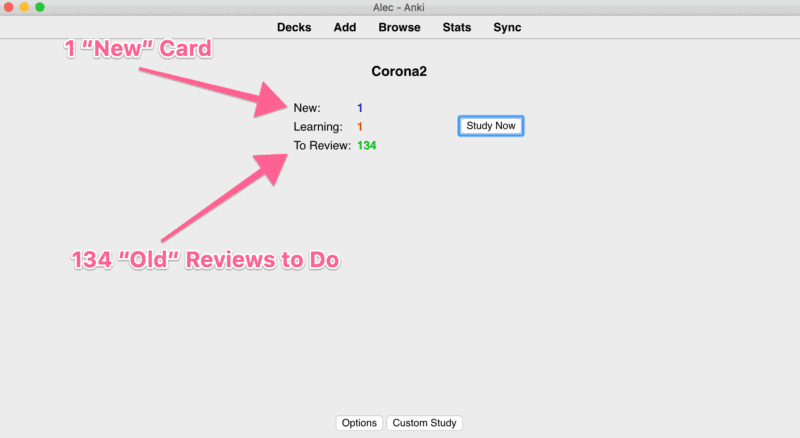
What is a “new” vs. “old” review? New cards = ones you haven’t seen before. “Old” reviews = cards you’ve seen before, that you’re supposed to review according to Anki.
However, after multiple correct reviews, I will remember that information for much longer. Anki will show me that information much later.
For illustration, the average interval for my cards is 4 years. That means, on average, I will remember my cards for 4 years. I can remember so much information because I have done my Anki reviews daily for 10+ years.
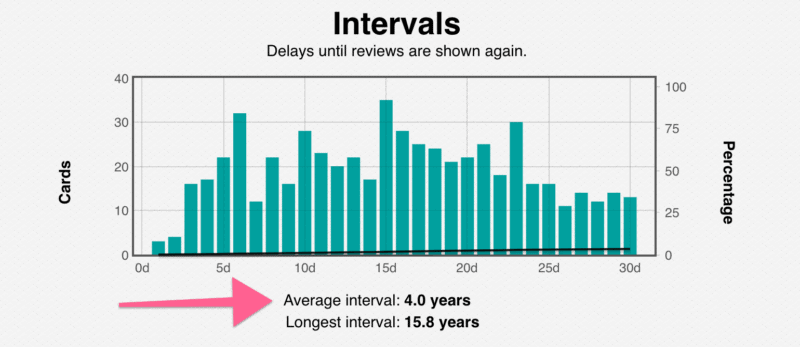
On average, I will remember my cards for 4 years. How? Because for the past 10 years, I’ve done my Anki reviews every day.
At a Minimum, Do Your “Due” Cards Every Day
Every day, the program will prompt you to review all your “due” cards. This is the information the algorithm predicts you are most likely to forget on that day.
If you do NOT review your cards every day, you will forget more information. Plus, it will be harder to catch up on your cards in subsequent days.
Let’s say you were scheduled to review 200 cards on Day 1, and 200 different cards on Day 2. If you skip today’s reviews, you increase the burden of tomorrow. So instead of doing 200 cards as planned, you will be doing 200 cards PLUS whatever you hadn’t done the day previous.
Finally, you will forget the skipped cards more often, and they will take longer to review.
Some of the most painful days of med school have been when I skipped 1-2 days of reviews. Please learn from my mistakes and review your cards every day.
5. How Many New Cards Should I Make/Review Every Day?
Short Answer:
Make and review 30-40 new cards/day to start. You may do more as you become more comfortable, but be careful to minimize lists/memorization.
Detailed Answer:
Recall the three most common mistakes students make with Anki are:
- Memorizing lists of facts without understanding the underlying concepts
- Making cards on everything that “might” be useful
- Not doing their Anki reviews every day
It’s easy to make 100+ Anki cards in a day. The problems with making lots of Anki cards is:
- They’re usually not very good
- Your day will be filled with Anki and nothing else (like QBanks)
Instead, force yourself to make only 30-40 new cards/day to start. (New cards are ones you haven’t reviewed yet. Remember: you should be doing all “old” reviews every day). You can review the cards the same day you make them using this article here.
If you’re struggling, try the Yousmle Step 1 or Step 2 CK cards. They will help you learn what a high-quality card is, and focus your time on mastery rather than re-creating the wheel.
6. What Settings Should I Use for My Anki Reviews?
Short Answer:
Set new cards to 40 max until you’re comfortable with the card load. Set “maximum reviews/day” to 9999.
Detailed Answer:
Anki defaults to 100 old cards reviewed/day. Even if 200 cards might be due on that particular day, Anki will only show you 100 old reviews.
This is meant not to overwhelm you. However, it doesn’t allow you to use Anki to the fullest, so I recommend setting it to some high number (e.g., 9999).
7. What Should I Put Into My Med School Anki Cards?
Short Answer:
Don’t memorize. Stick to the most important concepts/facts, by using:
- First Aid information (especially if you can make sense of it),
- QBank “educational objectives” w/ explanations,
- Pathogenesis to presentation cards from sources like Pathoma
Detailed Answer:
How many cards you make – and what kinds – is a critical element to med school Anki success. Get it wrong, and you’ll create a lot of unnecessary suffering for yourself. Get it right, and you can have skyrocketing USMLE scores.
There is a collective delirium in medicine that the key to success in medicine is to cram lists of facts. They believe the more you memorize, the better you will do on Step 1.
How is it, though, that people who score 250+ never credit memorization as the key? Every single person I’ve met/tutored with 250+/260+ on USMLEs did it via mastery, not memorization. I’ve spoken with USMLE test-writers who say the same thing: memorization courts disappointment.
Memorization is a Fool’s Errand
I’ve worked with many students who previously failed the USMLE. Every one of them tells the same story:
They tried to memorize their way through. No matter how many times they repeated UFAP, they couldn’t seem to raise their scores.
The problem wasn’t in the resources. (Although generally, I prefer active over passive learning). The problem was that they’d given up on trying to learn mechanisms, and simply relied on memorization.
To read more about what I put into my Anki cards, read this article.
8. How Long Should it Take to Review Anki Every Day?
Short answer:
- Old cards: ≤ 1 hour per 100 reviews
- New cards: 1-2 minutes/new review
Detailed answer:
I aim for reviewing 100 old cards/hour, and 1-2 minutes per new card reviewed. In other words, let’s say you had:
- 300 old cards and
- 45 new cards to review
I would expect it to take ~4 hours total (3 hrs for the old cards, and 45-90 mins for the new cards).
Cards that take too long will steal valuable time spent on other things, including:
- QBanks
- Mastery of topics, and
- Having a chance at a semi-normal life outside of medicine
What if it takes you more than an hour to do 100 old reviews? It’s usually because:
Cards Are Too Long
This is the #1 reason each card is taking too long. If there is too much information on each card, it will take you too long. You can check out Basic Anki Card Creation: The Complete Guide for Med School and the USMLE Step Exams. See the Yousmle Step 1 and Step 2 CK cards for examples of cards that are an appropriate length.
Perfectionism
Some people go overboard, and try to learn every single word of every card. That’s a mistake. Instead, make sure you understand the concept.
Distractions (e.g., Email, Social Media, Internet, etc.)
Email gets me every time. As does news sites. If you find distractions always block your focus, look at programs like Freedom.
Reviews When You’re Tired/At Night
Good Anki cards – the ones with deeper explanations/connections – require focus. It’s harder to do these cards late at night. For example, it takes me roughly 50% more time to do cards late at night compared with the morning. Be sure you are getting enough sleep, and that you’re doing your reviews when you’re energized, not tired.
9. Should I Stop Reviewing My Old Anki Cards After Each School Exam?
Short Answer:
If you made good cards, I’d recommend continuing them. If they’re pure memorization? Maybe not. (But you shouldn’t make memorization-heavy cards, to begin with, right?)
Detailed Answer:
This is a personal question, and the answer will depend on your particular goals. My goals were to:
- Learn information well for the exam, but also to
- Dominate the USMLE Step 1 exam,
- Make Shelf studying easier,
- Know more answers on rounds, and ultimately
- Be a better doctor/teacher who could explain not only what treatment we were doing, but also why
As such, even after a particular school exam, I continued to review all the Anki cards from that subject. Because the cards fostered mastery – not memorization – I accomplished those goals. (And much more).
“But Weren’t the Cards From Your School Exams’ Low-Yield’ for Step 1?
Students obsess over “high-yield” subjects for the USMLEs. (“High yield” means things that are tested more often than others). However, the truth is that no one knows what will be on their test before they take it.
(To read How to Ensure Your USMLE Studying is “High Yield”, click here).
They can test you on (almost) anything. Particularly if you want a 250+, you need to move beyond UFAP.
You’ve heard stories from high-scorers who got questions right only from lecture material. Are these common? Probably not. But then again, getting a 250+ on the USMLE is not common, either.
Let me be clear: this is not to say that you should memorize every detail in lecture. UFAP is an excellent start if you use it properly.
Ultimately, it depends on what you believe good USMLE scores require. Do you take the NBME at their word, that they want you to master concepts and not memorize details? Then continue your old cards. Do you think the USMLEs are about remembering facts? Then doing your old cards probably doesn’t make sense to you.
10. What Are the Benefits of Reviewing All of Your Old Anki Cards?
Short Answer:
There are many benefits, as long as they’re good cards. Benefits include minimizing re-learning the same information and facilitating learning later blocks.
Long Answer:
It’s common to learn subjects only for our upcoming test and forget it afterward. However, retaining prior content will accelerate future studying.
Many concepts within medicine repeat in later blocks. You can’t understand pulmonary edema without understanding cardiology/heart failure. Biochemistry comes back with a vengeance in GI and endocrinology. Diabetic ketoacidosis spans biochemistry, GI, and endocrinology.
At Stanford, I could explain things that many of my classmates needed to memorize. Why? Because I had retained the explanations from previous lectures. Additionally, so many subjects repeated over and over. As such, I spend less time re-learning topics that came up again and again.
For example, we’d covered renal physiology in our pharmacology diuretics section. I continued to review those cards after our exam. As a result, I breezed through the same information later during out:
- Cardiology’s hypertension management lecture, as well as
- Renal physiology lectures
If you’ve invested the time to make/do high-quality reviews, it pays to continue them.
11. What Should I Do with My Anki Cards After I Finish Step 1?
Short Answer:
I continued virtually all my cards, which helped immensely for Shelf exams, and Step 2 CK. It’s hard to do all your reviews if you don’t have time off after your second year, although people have made it work.
Detailed Answer:
Again, this is a very personal question. It will depend on your goals and your particular circumstances. I was fortunate to have received an HHMI Research Fellowship after my second year. As such, I took a research year after the USMLE Step 1.
At their peak could take roughly 2-3 hours a day to review ~250-300 old cards. By having a research year, I had the time to continue those reviews.
The demands of clinical clerkships are more significant than a typical research year. It’s daunting to find time for:
- Doing old Anki cards, while simultaneously
- Learning the ropes on an inpatient service and
- Studying for a shelf exam is daunting
The benefits of continuing your Step 1 reviews? Recalling the majority of Step 1/class information helped immensely for Shelf exams. (I honored all my third-year Shelf exams by only doing QBank questions). Additionally, despite a year off before clerkships, the information was still fresh. It also helped a LOT for answering questions on rounds.
12. What Is the Best Way to Study Anki Cards During Clerkships?
Short Answer:
Use hospital computers, and use Ankiweb. Avoid studying on your phone.
Detailed Answer:
I’m going to level with you. As a clerkship student, you are:
- Expected to be in the hospital for long hours
- Unable to do a lot of useful tasks
You also have all-important clerkships evaluations, which are high subjective.
It’s one of the most frustrating positions to be in. You are capable of writing a good progress note. However, even if you did, they can’t use it for billing purposes, so the intern will write their own. You can’t put in orders, and at least in the beginning, you don’t have a lot of useful skills.
But you also have a Shelf exam to study for! Often, the optics of studying for an exam while in the hospital aren’t good. Even worse, if someone sees you on your phone, they will assume you’re:
- Checking your email
- On Facebook
- Don’t care
Do Anki Cards on Hospital Computers Using Ankiweb
So how can you do your Anki cards, while not invoking the rage of your team? By studying on a hospital computer, using Ankiweb. Ankiweb is a cloud-based application you can use to study your cards from anywhere. All you have to do is create an account, and sync it with your mobile/desktop app.
The added benefit of studying on a hospital computer is that you can do useful work. A lot of inpatient medicine involves waiting. Waiting for:
- Labs
- Consult recommendations
- Radiology reads
- Social work/disposition plans
Your team likely has a lot of things they need to do. If you check every 15-20 minutes for updates on the things you’re waiting for, you can be a huge help. You can also avoid looking disengaged.
13. How Many Anki Decks Should I Make? Should I Have One Large Deck, or Decks for Each Lecture?
Short Answer:
I recommend making 2 decks, pharmacology, and non-pharm (including pathology, physiology, micro, etc.). At most, 3 if you’d like a separate micro deck.
Detailed Answer:
The more decks you make, the more tedious reviews become. As such, I recommend creating fewer decks.
For example, let’s say I made six separate decks for:
- Renal,
- Cardiology,
- Pharmacology,
- Pathology,
- Physiology, and
- Microbiology,
Instead of opening a single deck, every day, I’d have to open six. It might not seem like much in the beginning. However, this becomes very tedious (not to mention discouraging). Any friction to reviewing your cards makes it less likely you’ll actually do them.
Study Step 1 Pharmacology Separately So You Can Learn It Little by Little
So why would I recommend making two decks instead of one? Because having lots of pharmacology cards can overwhelm a single deck. To illustrate this, let’s say that I had one deck, with:
- 1,000 non-pharmacology cards in it, 100 of which are “new.” (“New” meaning I have created them but not reviewed them yet).
One day, I get on a roll, drink a glass of wine or two, and create 500 pharmacology cards at once. Now, among my new cards, I have:
- 100 non-pharmacology questions, and
- 500 pharmacology questions.
However, I have a problem. If I were to review 40 new cards a day, roughly 5 in 6 of them would be pharmacology cards. This means I would only be moving through my new non-pharmacology cards at 1/6th the pace.
Learning pharmacology is one of the most challenging tasks for the USMLE Step 1. It’s also hugely rewarding.
The most effective way to learn pharmacology is to do it bit by bit. Many students cram pharmacology during the last several weeks before their exam. Virtually every crammer regrets it, as it is painful and ineffective.
Instead, create a separate pharmacology deck. Set the daily new card review limit to something reasonable, like 20 cards a day.
If you’re trying to blitz microbiology, you may attempt the same thing, and create a third deck.
(To read How to Master Step 1 Pharmacology Over a Glass of Wine, click here).
14. How Can I Get All of Alec’s Cards He Used to Score 270 on Step 1?
It sounds tantalizingly simple: learn the cards from a high-scorer, and get the same score! Unfortunately, it’s never that easy.
By the time I took Step 1, I had 15,000+ cards I’d made in the 1.5 years preceding my exam. Trying to do all the cards would be counterproductive. You likely wouldn’t have enough time to get through them. Even if there were enough time, it would away time for other critical activities. Most importantly, many of the explanations would only make sense to me.
Think about this the next time you consider using Zanki or other “comprehensive” deck. (I don’t recommend Zanki, nor does this former Zanki/Brosencephalon user).
Instead, I’ve created Step 1, Step 2 CK, and Pharmacology Decks for sale. These decks:
- Explain the most challenging/ important USMLE topics
- Make connections that will allow you to interpret any question on your exam
- Are the right length, so if you want, you can make better cards yourself
Each contains a much more manageable number of cards (1200-1800+). From my constant work as a tutor, these cards help you master the most challenging topics.
Click to learn more about the Step 1 and Step 2CK Anki decks.
15. ???
I’m sure there are questions here that I haven’t addressed. Let us know what your questions are in the comments section!
What to Do Next?
- Check out the Resources Page for my top recommendations of tools I used to score 270
- If you haven’t yet, download Anki
- Stressed for time? Invest in AnkiMobile – I’ve saved literally hundreds if not thousands of hours by being able to review my cards whenever I have a spare moment (on the bus, waiting for a consult to call me back, etc.)
- If you’re starting for the first time, remember to start slow (target 30-40 cards/day to make, and to add to your deck). The key is to develop good habits, and then to expand your reviews as you become more comfortable.
- Leave a comment below with your own question(s)!
Photo by George Donnelly



